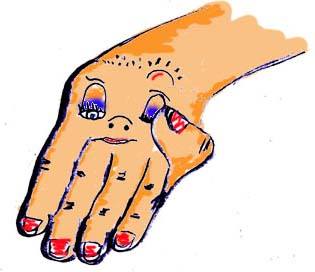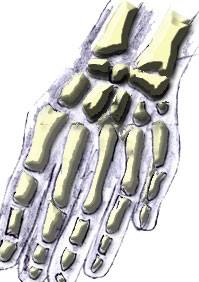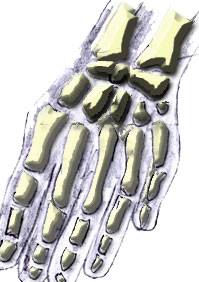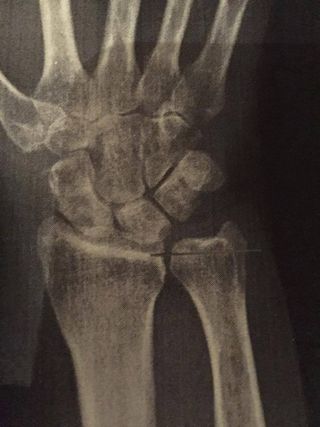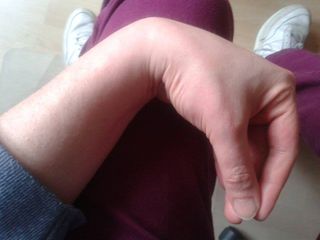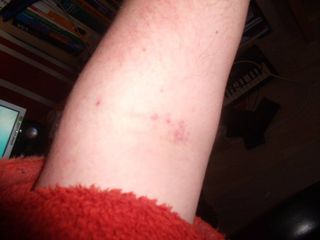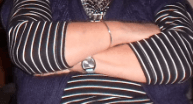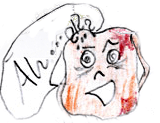Discussed causes of lunate malacia
An ulna plus variant. Here the ulna (ulna) is longer than the radius (spoke) - a lot of people have this variant, but not everyone has a lunate malacia as a result. In such a case, shortening the radius would make little sense in order to relieve the small lunate - even shorter? Not possible, of course, so here a shortening of the ulna instead of the radius might be an option
Here you can see the "normal position" of the ulna and radius to each other based on an X-ray image. Above it is an ulna plus variant (as here), underneath a ulna minus variant and, for example, on the line the ulna zero variant / -0 variant. All 3 variants are common even without lunate malacia or osteoarthritis (early type). However, the plus and minus variants unfortunately have a positive influence on the development of lunate malacia.
Conclusion: There is no such thing as a "normal" hand in bone structure - all 3 ulna variants are adequately considered normal as long as no bone disease occurs - how illogical is that?
"Blood values" show everything ... Some are deficient in vitamins, nutrients in the bone structure. Phosphorus, sulfur as so-called. Vitamin P, Vitamin B, Hormones. Others have an excess: iron, uric acid, glycose (rather the insulin balance is wrong), hormones. Deficiency symptoms and excesses can also trigger lunate malacia, but are only noticeable if not only one bone is affected. Usually it doesn't start on the lunate either ... so other diseases are sometimes associated and have additional symptoms.
"Nutrition is always to blame" - a lot can be explained by nutrition. Deficiency symptoms, excesses, overweight, underweight. Blood values can be controlled through an adapted diet. And some illnesses that are reflected in the blood values can be positively influenced in terms of symptoms and consequences through the appropriate diet. Adjusting your diet is never a bad thing.
Illogical in terms of lunate malacia:
Circulatory disorder is a proven cause. The bones don't get enough nutrients to survive. How is he supposed to get hold of them if the blood cannot bring the nutrients from the food there? - Numerous dietary changes can be made, maybe even slowing down a process, but they do not stop it in terms of lunate malacia. - So far :)
Obesity - clearly, too much ballast for your hand? Why do underweight people also have lunate malacia? Who says that normal weight can't get lunate malacia? And who says that normal really corresponds to a BMI or other supposed norm values?
A balanced diet is the best medicine. Diet can really support healing processes, some prefer to use dietary supplements instead of a healthy, balanced diet. There are also differences:
natural nutritional supplements from naturopathy and chemical nutritional supplements with an additional risk of unnecessary deposits in the body that the body cannot break down.
A calcium-rich diet such as milk is temporarily not bad, but does the body not build up compression of the bone structure as an excess if it is consumed over a long period of time? So be careful.
Temporarily in the healing time: Dairy products, green vegetables maybe raise a little. Then balanced again. ;)
Diseases such as gout, diabetes, rheumatism, arthritis, fibromyalgia, etc. lead to changes in diet and special features.
Gout: Deposition of uric acid crystals in joints
Diabetes: deposition of sugar crystals beginning at nerve endings of the extreme extremities.
Arthritis: Inflammation, diet changes such as low purine is often recommended. Fibromyalgia: uncoordinated pain points with no proven findings, a diet that is particularly sensitive to specific fats is recommended. Etc.
Movement and sport. Overweight people are lazy - the first prejudice quickly emerges. Underweight and normal weight people do a lot of sport - we have the opposite prejudice. There are lazy over-, under- and normal-weight people as well as sporty people in every group. - So outward appearances say nothing about behavior. There are many sports in which lunate malacia can occur in athletes as well as couch potatoes. So there is no cause to be looked for here. Rather, there is an increased risk for those who have unfavorable falls and a minimally invasive undetected / untreated fracture in the carpal area - usually the lunate or navicular bone. A hairline crack. "Grows out" - definitely proven to be the cause, not all of them grow out as one would like, they sometimes cause necrosis (also a synonym for lunate malacia).
Nicotine is generally regarded as not good for blood vessels and the like. Lunate malignancy affects both smokers and non-smokers - not a real cause, but certainly promoting circulatory disorders (think of smokers 'legs, etc.) There are no smokers' hands in the form of the wrist and, more precisely, as lunate necrosis.







